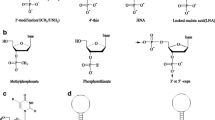Abstract
In vitro selection of aptamers requires the reliable enzymatic preparation of large amounts of (+) single-stranded DNA molecules. This can be achieved by selective enzymatic digest of 5′-phosphorylated (−) strands from PCR products, a method already widely used in sequencing of PCR products. Here we present an adaptation of this method to prepare large pools of single-stranded DNA molecules for in vitro selection.
Similar content being viewed by others
References
Tuerk, C. and Gold, L. (1990) Systematic evolution of ligands by exponential enrichment: RNA ligands to bacteriophage T4 DNA polymerase.Science 249, 505–510.
Ellington, A. D. and Szostak, J. W. (1990) In vitro selection of RNA molecules that bind specific ligands.Nature 346, 818–822.
Gold, L., Tuerk, C., Allen, P., Binkley, J., Brown, D., Green, L., MacDougal, S., Schneider, D., Tasset, D., and Eddy, S. (1993) Chap. 19, inThe RNA World (Gesteland, A. and Atkins, J., eds.), Cold Spring Harbor Laboratory Press, Plainview, NY, pp. 497–509.
Ellington, A. D. (1994) Using in vitro nucleic acids selection for conventional drug design. Research overview.Drug Dev. Res. 33, 102–115.
Ellington, A. D. and Szostak, J. W. (1992) Selection in vitro of single-stranded DNA molecules that fold into specific ligand-binding structures.Nature 355, 850–852.
Bock, L. C., Griffin, L. C., Lantham, J. A., Vermaas, E. H., and Toole, J. J. (1992) Selection of singlestranded DNA molecules that bind and inhibit human thrombin.Nature 355, 564–566.
Cui, Y., Wang, Q., Stormo, G. D., and Calvo, J. M. (1995) A consensus sequence for binding of Lrp to DNA.J. Bacteriol. 177, 4872–4880.
Schneider, D. J., Feigon, J., Hostomsky, Z., and Gold, L. (1995) High-affinity ssDNA inhibitors of the reverse transcriptase of type 1 human immunodeficiency virus.Biochemistry 34, 9599–9610.
Gyllensten, U. B. and Erlich, H. A. (1988) Generation of single-stranded DNA by the polymerase chain reaction and its application to direct sequencing of the HLA-DQA locus.Proc. Natl. Acad. Sci. USA 85, 7652–7656.
Huizenga, D. E. and Szostak, J. W. (1995) A DNA aptamer that binds adenosine and ATP.Biochemistry 34, 656–665.
Hultman, T., Stahl, S., Moks, T., and Uhlen, M. (1988) Approaches to solid phase DNA sequencing.Nucleosides and Nucleotides 7, 629–638.
Williams, K. P. and Bartel, D. P. (1995) PCR product with strands of unequal length.Nucleic Acids Res. 23, 4220, 4221.
Little, J. W., Lehman, I. R., and Kaiser, A. D. (1967) An exonuclease induced by bacteriophage lambda. I. Preparation of the crystalline enzyme.J. Biol. Chem. 242, 672.
Author information
Authors and Affiliations
Corresponding author
Rights and permissions
About this article
Cite this article
Kujau, M.J., Wölfl, S. Efficient preparation of single-stranded DNA for in vitro selection. Mol Biotechnol 7, 333–335 (1997). https://doi.org/10.1007/BF02740823
Issue Date:
DOI: https://doi.org/10.1007/BF02740823




